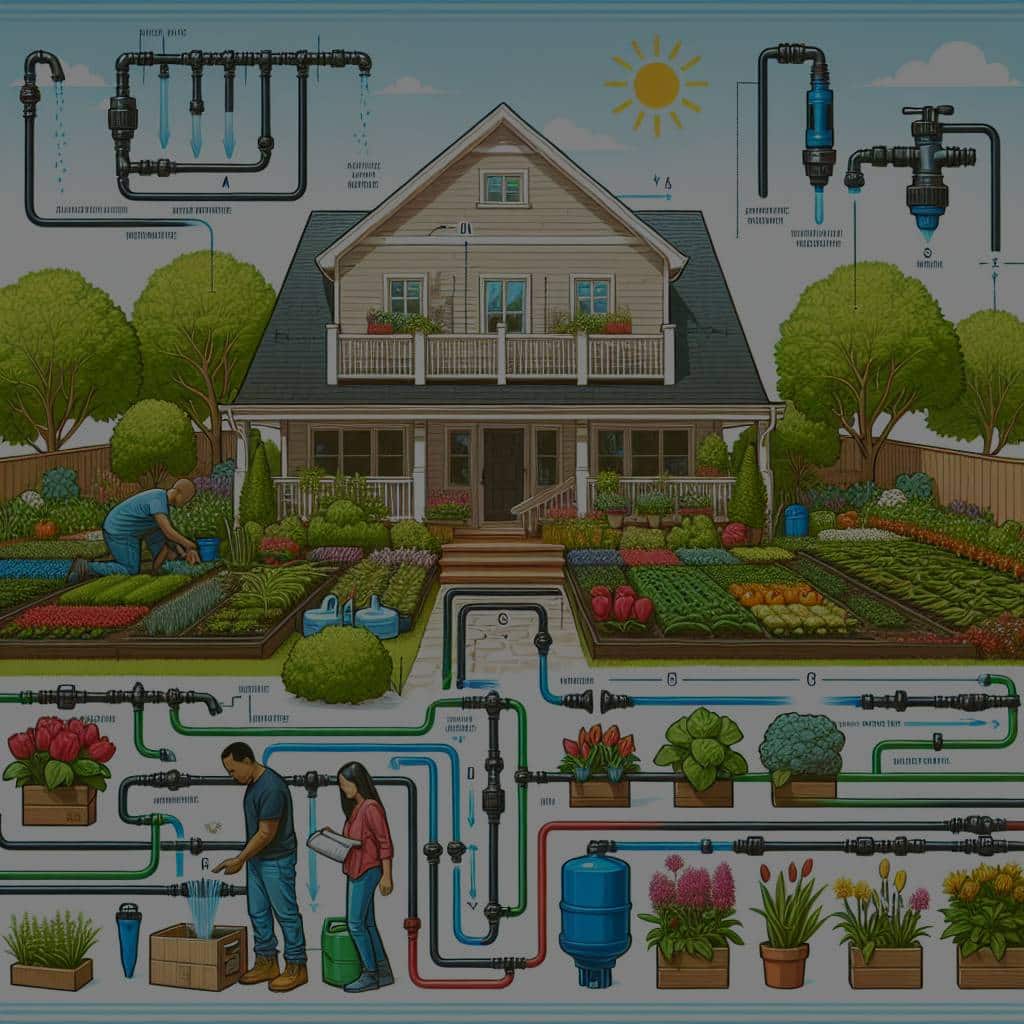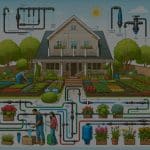For many homeowners, maintaining a lush, verdant lawn and a bountiful garden is a matter of pride. Watering your landscape is therefore an essential duty, but it can also be a time-consuming and tedious task. However, with the right irrigation system, this chore can be significantly simplified. Specifically, drip irrigation systems are highly efficient, conserve water, and promote healthy plant growth. In this article, we’ll guide you through the process of implementing a high-efficiency drip irrigation system in your suburban home garden.
Understanding the Basics of Drip Irrigation Systems
To effectively set up a drip irrigation system, it’s important to understand the basics. Drip irrigation, a method that allows water to drip slowly to the roots of the plants, is one of the most efficient watering systems. It involves placing a network of tubes, pipes, valves, and emitters around your garden to deliver water directly to the plant’s root zone. This method minimizes water wastage and encourages a healthier, more vibrant garden.
In the same genre : What Are the Top Smart Gadgets for Efficiently Monitoring Home Energy Usage?
Compared to traditional watering methods, drip irrigation systems are more beneficial as they help conserve water, reduce soil erosion, and decrease nutrient leaching. They also require less time and labor and can be easily customized to meet the watering needs of different plants or areas in your garden.
Evaluating Your Garden’s Irrigation Needs
Before installing a drip irrigation system, you should evaluate your garden’s irrigation needs. Different plants and lawns require different amounts of water, and you should tailor your system to meet these needs.
In the same genre : What Are the Best Techniques for Waterproofing a Basement Against Flood Damage?
Start by assessing the soil type in your garden. Different soils have different water retention abilities. For instance, sandy soil drains water quickly, so you might need to water more often. On the contrary, clay soil retains water for a longer time, therefore requires less frequent watering.
Next, pay attention to the types of plants in your garden. Each plant species has a unique watering requirement. For instance, lawns typically require more water than shrubs or flower beds. Understanding these needs will help you design an efficient drip irrigation system.
Planning Your Drip Irrigation System
Once you’ve evaluated your garden’s irrigation needs, the next step is to plan your drip irrigation system. This involves mapping out your garden and deciding where to place the mainline, the drip lines, and the emitters.
The mainline, usually a PVC pipe or a durable hose, will carry the water from your home’s water source to your garden. The drip lines, thin tubing connected to the mainline, will distribute the water throughout your garden. Emitters, small devices attached to the drip lines, will deliver the water directly to the plants.
Consider grouping plants with similar watering needs together. This allows you to customize the watering frequency and volume for each group, leading to a more efficient use of water and healthier plants.
Installing Your Drip Irrigation System
With your plan in hand, you are now ready to install your drip irrigation system. Start by installing the mainline. Connect it to your home’s water source, making sure to include a backflow preventer to keep your water supply safe. Run the mainline to your garden, following the path you’ve laid out in your plan.
Next, connect the drip lines to the mainline. Run these lines along your garden beds, ensuring each plant is within reach of an emitter. Attach the emitters to the drip lines, positioning them to drip water at the base of your plants.
Finally, install a timer to automate your watering. A timer allows you to water your garden at the best time for your plants, usually early in the morning or late in the evening, when water evaporation is minimal.
Maintaining Your Drip Irrigation System
Once your system is installed, regular maintenance will ensure it continues to work efficiently. This involves checking the system for leaks, cleaning the emitters, and adjusting the timer as necessary to accommodate changes in weather or plant growth.
In conclusion, a drip irrigation system is a valuable addition to your suburban home garden. With careful planning and regular maintenance, this system can simplify your gardening routine, conserve water, and help you cultivate a beautiful, thriving landscape. But remember, every garden is unique, so take the time to understand your garden’s specific needs and design your system accordingly. Your plants will thank you for it!
Rainwater Harvesting and Drip Irrigation
Rainwater harvesting is an eco-friendly method of collecting and storing rainwater for future use. It’s a way to supplement your water supply, and it can be particularly useful for drip irrigation systems.
To start with, you’ll need to set up a rainwater harvesting system. This usually involves installing gutters on your home to catch rainwater, a downspout to direct the water, and a barrel or tank to store the water. Make sure to install a filter to remove debris and a cover to prevent mosquitoes and other pests from breeding in the stored water.
Once you have a rainwater harvesting system in place, you can connect it to your drip irrigation system. Simply connect your garden hose or soaker hose from the storage tank to the mainline of your drip system. Remember to install a pump if the pressure from the tank is not sufficient to deliver water to your entire garden.
Using harvested rainwater for your drip irrigation has several benefits. Firstly, rainwater is free and can reduce your water bills. Secondly, rainwater is typically softer and free of chlorine and other chemicals found in tap water, making it healthier for your plants. Lastly, using harvested rainwater is an excellent way to conserve water.
Overhead Watering Vs. Drip Irrigation
You might be wondering why you should consider setting up a drip irrigation system instead of sticking to traditional overhead watering methods. The key difference lies in their efficiency and impact on your plants and the environment.
Overhead watering involves spraying water over the top of your plants, similar to natural rainfall. While this method can effectively water your lawn, it also leads to a significant amount of water loss through evaporation and runoff. Moreover, water can easily land on the leaves instead of the roots, which can promote the growth of fungal diseases.
On the other hand, a drip irrigation system provides water directly to the root zone of your plants. This targeted watering reduces water waste and promotes healthy plant growth. Additionally, drip irrigation allows you to water your plants even during water restrictions or drought conditions.
Conclusion
Implementing a high-efficiency drip irrigation system in your suburban home garden is not as daunting as it may seem. Once you understand the basics of drip irrigation, evaluate your garden’s irrigation needs, plan your drip system, and install it, you’ll find that it is a worthwhile investment. Not only does it simplify your watering routine, but it also promotes a vibrant, healthy garden.
Maintenance is crucial to ensure the ongoing efficiency of your system. Regular checks and cleaning are necessary parts of keeping your system in top shape. To further enhance the eco-friendly nature of your garden, consider incorporating rainwater harvesting into your irrigation system.
Remember, a well-planned and well-maintained drip irrigation system can help your garden thrive while conserving water. It’s a sustainable, efficient, and eco-friendly way to nurture your beautiful suburban home garden.
















